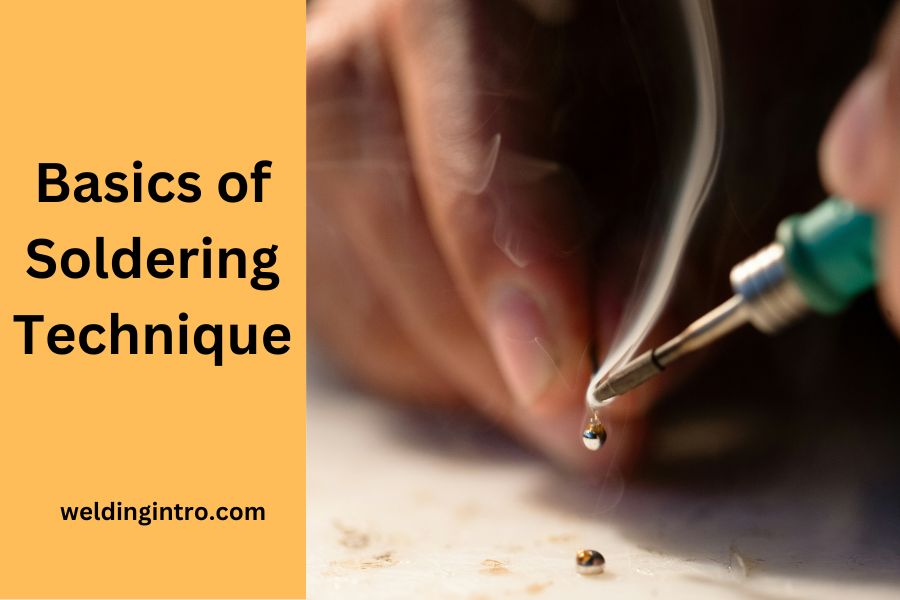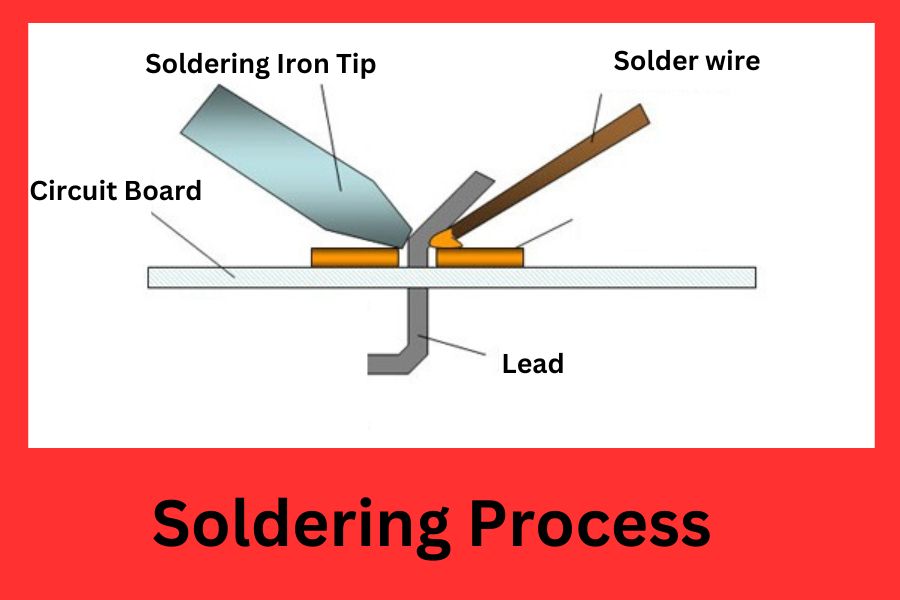Soldering is a welding process used to join two or more metal components. In this process a solder, a metal alloy made of tin & lead, is melted and flown into the joint by heating with a iron rod. The iron is heated to temperature amounting to 600 degrees Fahrenheit. When the solder cools down, a strong and permanent bond is created.

Process of Soldering
In the soldering process an iron rod is required which is connected to a power source that supplies the heat. The rod is heated to the temperature beyond the melting point of the solder. Then, the solder is melted by the heat supplied through the iron rod. After cooling down it creates a strong weld.

Here the solder is basically a filler metal made of lead or lead free copper. Inside the solder flux is present which prevents the oxidation, oil and dirt making the mechanical bond stronger. The iron rod works as a welding torch of other welding techniques and heats the solder to melt and bond together. That is how soldering works and it is an easy and simple welding process.
Metals Used in Soldering
Normally lead based filler metals are used in soldering. But lead is a very dangerous element and when the fumes of lead are inhaled, various diseases like cancer can take place in the human body.
That’s why lead is banned in most of the countries and instead lead free filler metal is being used in the soldering process nowadays. Antimony, bismuth, brass, copper, indium, tin & silver is taking the place of lead in modern soldering work.
Components Of Soldering
1. Flux
Rosin flux is a common soldering process. We know that flux prevents impurities, oil and oxidation while melting the metal for joining purpose. So it is important. Rosin flux is derived from natural pine tar resin which has been used for more than thousands years for soldering purposes.
Rosin flux is a non-corrosive element that leaves no residue and cleans the metal as soldering goes on. It removes the oxidation from the surface of the base. It has a low melting point which is the most important reason for using the flux in soldering.
2. Solder Iron
Soldering iron is a hand tool that is connected to the electric source or power supply machine. The iron conveys the electric heat to the filler metal or solder, melting it by supplying heat beyond the melting point of the base metal or plastic base. It melts the solder and flows the melted solder to the connection of pieces to be joined.
The iron rod contains an insulated handle and a point tip at the edge of the rod. The tip is important for the best soldering result. If the tip is clean and well maintained, no issue would arise while soldering. To do so, you need to clean the tip with the help of a wet sponge prior to starting soldering.
3. Solder Sucker
In addition you may need to use a solder sucker. It is an important tool to suck the excessive solder applied on the joint.
4. Soldering Gun
Another important element is a solder gun. It is a special type of gun that holds the solder iron. It conveys temperature to soldering iron and heat it to melt the solder. This one is used in joining stained glass, light sheet metal projects while it is required to solder intermittently.
5. De-soldering Gun
There is also another important tool which is called a de-soldering machine. It corrects the soldering mistakes just by de-soldering the soldered joint.
Types of Soldering
There are 3 types of soldering. They are
- Soft Soldering
Soft soldering is a joining process that employs low-melting-point alloys, known as soft solders, to create bonds between metal components. Soft soldering typically occurs at temperatures below 450 degrees Celsius (840 degrees Fahrenheit). It stresses the components at the lowest point and thus is not suitable for load bearing projects.
- Hard Soldering
It is a joining process that involves the use of alloys with higher melting points compared to soft soldering. Normally brass or silver is used in the process and a blow torch is required to supply the temperature at which the solder melts. It basically creates more than 450°C temperature.
- Brazing
Brazing involves melting a filler metal, often a brass or silver alloy with a higher melting point than that used in soldering, to create a strong and durable joint between metal workpieces. Here both metal pieces are heated beyond melting point and then a solder is placed between the workpieces so that it is melted and flown to join the pieces together.
Projects
Soldering is a crucial technique in various projects across different fields. This technique is commonly employed in electronics, plumbing, and metalworking to create strong and reliable connections between components, such as electrical circuits or pipes.
Here are some examples of projects where soldering is commonly used:
- Electronics Projects:
- Building and repairing electronic circuits.
- Assembling and modifying electronic devices, such as radios, amplifiers, and controllers.
- Creating DIY gadgets and prototypes.
- Robotics:
- Constructing and wiring robot components.
- Connecting sensors, actuators, and microcontrollers in robotics projects.
- DIY Audio Projects:
- Building audio amplifiers, preamplifiers, or audio interfaces.
- Modifying and customizing audio equipment.
- Model Making:
- Assembling and wiring model train sets.
- Building scale models of vehicles, aircraft, or buildings with electronic components.
- Automotive Projects:
- Repairing or modifying car electronics.
- Installing aftermarket accessories, such as audio systems or lighting.
- Home Automation:
- Creating smart home devices and sensors.
- Integrating and customizing smart home systems.
- Computer Hardware:
- Assembling and upgrading computer components.
- Repairing or modifying circuitry on computer motherboards.
- DIY Led Projects:
- Building custom LED displays or lighting systems.
- Creating illuminated artwork or signs.
- Amateur Radio:
- Building and assembling radio transmitters, receivers, and antennas.
- Jewelry Making:
- Crafting custom jewelry with electronic components, such as LED accents.
- Creating wearable technology projects.
- DIY Drones:
- Assembling and customizing drone components.
- Integrating and configuring flight controllers and sensors.
- School Science Projects:
- Creating science fair projects involving electronic circuits.
- Building simple electronic devices for educational purposes.
Advantages
Soldering offers several advantages, making it a widely used technique in various industries and applications. Here are some key advantages of soldering:
- Permanent Joints: Soldered joints are often durable and permanent, providing a secure and long-lasting connection between components.
- Conductivity: Soldered connections maintain excellent electrical conductivity, ensuring efficient transfer of electrical signals and currents in electronic circuits.
- Low Heat Impact: Soldering typically involves lower temperatures compared to welding, minimizing the risk of heat damage to sensitive components or materials being joined.
- Ease of Use: Soldering is a relatively straightforward process, making it accessible to both beginners and experienced craftsmen. Basic soldering skills can be quickly learned and applied.
- Cost-Effective: Soldering equipment and materials are generally more affordable compared to some alternative joining methods like welding. This makes it a cost-effective choice for various applications.
- Repairability: Soldered joints are often easier to desolder than welded or glued joints, facilitating the repair and replacement of components in electronic devices and other applications.
- Clean Appearance: Soldered joints tend to have a clean and professional appearance, making them aesthetically pleasing, especially in projects where visual appeal is important.
- Reduced Mechanical Stress: Soldering creates joints with lower mechanical stress, reducing the likelihood of damage to delicate components or materials during the joining process.
- Wide Range of Soldiers: There are various types of solder alloys available, each with specific properties. This allows for customization based on the requirements of the project, such as electrical conductivity, melting point, and environmental considerations.
- Quick Assembly: Soldering can be a fast process, allowing for efficient assembly of components in mass production or prototyping scenarios.
- Environmental Considerations: Lead-free solder options are available for applications where environmental concerns dictate the avoidance of lead-based materials.
Overall, the advantages of soldering make it a versatile and widely used technique in numerous industries, ranging from electronics and telecommunications to plumbing and jewelry making.
Disadvantages
While soldering is a versatile and widely used joining method, it does have some disadvantages. Here are a few drawbacks associated with soldering:
- Non-Structural Strength: Soldered joints may not have the same structural strength as welded or mechanically fastened joints. In applications requiring high mechanical strength, alternative joining methods may be preferred.
- Temperature Sensitivity: Soldered joints can be sensitive to temperature changes. In high-temperature environments, there’s a risk of the solder melting, potentially compromising the integrity of the joint.
- Limited Joint Size: Soldering may not be suitable for large joints or heavy-duty applications. Welding or other methods might be more appropriate for projects requiring larger, stronger connections.
- Risk of Thermal Damage: Soldering involves the application of heat, which can pose a risk of thermal damage to heat-sensitive components, especially in electronics. Care must be taken to avoid overheating and causing harm to nearby materials.
- Environmental Concerns: Traditional solder alloys often contain lead, which is a toxic substance. While lead-free solder options are available to address environmental concerns, they may have different properties and require higher temperatures for melting.
Despite these disadvantages, it’s important to note that soldering remains a highly valuable and widely used technique in various applications. The choice of joining method depends on the specific requirements of the project, and soldering continues to offer numerous advantages for many scenarios.
Lastly
The solder typically has a lower melting point than the workpieces being joined, allowing it to create a bond without melting the base metals. Soldering is a versatile and widely used method for creating permanent or temporary connections in various industries.
Also Check